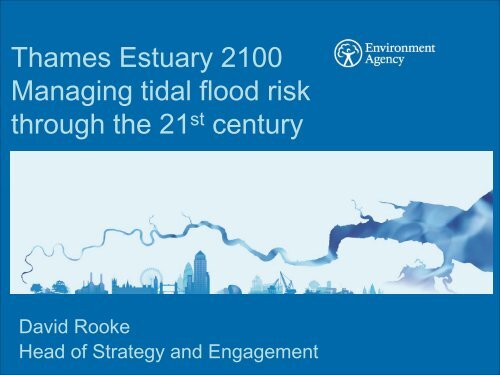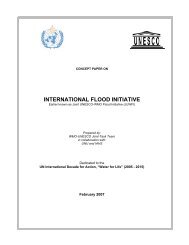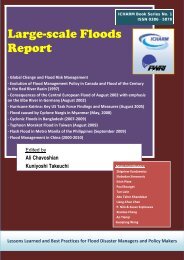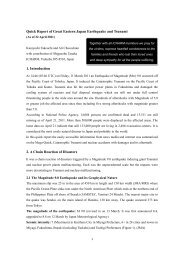Thames Estuary 2100 Managing tidal flood risk ... - (IFI)-Home Page
Thames Estuary 2100 Managing tidal flood risk ... - (IFI)-Home Page
Thames Estuary 2100 Managing tidal flood risk ... - (IFI)-Home Page
You also want an ePaper? Increase the reach of your titles
YUMPU automatically turns print PDFs into web optimized ePapers that Google loves.
<strong>Thames</strong> <strong>Estuary</strong> <strong>2100</strong><strong>Managing</strong> <strong>tidal</strong> <strong>flood</strong> <strong>risk</strong>through the 21 st centuryDavid RookeHead of Strategy and Engagement
Planning early
<strong>Managing</strong> <strong>flood</strong> <strong>risk</strong> in a diverse estuary
Adapting to climate change
Evidence based decision making
Involving others
Today’s <strong>Thames</strong> Tidal Defences….• Protect London and the <strong>Thames</strong> <strong>Estuary</strong> corridor wherea significant proportion of the nation’s wealth is produced(1.25 million people live and work in the <strong>flood</strong> <strong>risk</strong> area);• Provide 1:1000 protection (to 2030)• Allow for a combination of <strong>risk</strong>s (high tide/surge/freshwater)• Comprise 36 major barriers (9 of which including the <strong>Thames</strong>Barrier are owned and operated by the Agency), 400 minorbarriers and over 300 km of <strong>tidal</strong> walls and embankments
The TE<strong>2100</strong> PlanLondon ClimateChange AdaptationStrategyMaking Spacefor Water
<strong>Thames</strong> <strong>Estuary</strong> and Flood Risk Management• Area at <strong>risk</strong> of <strong>flood</strong>ing (primarily <strong>tidal</strong> <strong>flood</strong> <strong>risk</strong>)• 8 major Barriers and over 340km of defences• <strong>Thames</strong> Gateway …..Growth PointsRiver RodingRiver LeaTower Br.GreenwichBarking<strong>Thames</strong>meadTilburyGravesendCanveyIslandN KentMarshesSouthendSheernessMedwaySheppey
Improve existing defencesFlood StorageNew barrierBarrier with locksChange ahead? Our estuary-wide options
Raise defencesImproveconveyanceOr local secondary defences insome embayments?W. Londonfluvial storageImprove <strong>Thames</strong>BarrierMaximise <strong>tidal</strong> habitat /retreat defenceMaximise <strong>flood</strong>storage?Maximise <strong>tidal</strong> habitat+ options to reduceconsequences across thewhole estuary??A portfolio of <strong>flood</strong> <strong>risk</strong>management options
<strong>Managing</strong> Flood Risk through<strong>Thames</strong> <strong>Estuary</strong> <strong>2100</strong>• more people/property• climate change• ageing FDAcceptable level of <strong>risk</strong>(to be agreed with Government)2006 2050 <strong>2100</strong>Time
Estimated number of closures per year of the<strong>Thames</strong> Barrier under different climatechange scenarios700600Closure on every tideClosures per year500400300ScenariosMedium HighDefraHigh +20070 closures per year(preferred limit of operation)10002000 2020 2040 2060 2080 <strong>2100</strong> 2120Dateestimate, 2006)
Planning the Timetablefor InterventionsDecision/Action Point“Making Space”options (creatingnew space)Op7ExistingsystemDecision/action pointMaintenance +good planning“Making Space”options (currentopen space)ModestDefenceraisingMajorDefenceraising &Barrier workOp3Op4Op2New BarrierOp5??Op1Spatial Planning policy tosafeguard optionsMajorDefenceraising andbarrier workOp62006 2050 <strong>2100</strong>Time
TE<strong>2100</strong> the first 25 Years• Continue to maintain the current <strong>flood</strong> defencesystem including planned improvements• Ensuring that <strong>flood</strong>plain management is inplace across the estuary• Safeguard areas that may be required forfuture changes to <strong>flood</strong> defences• Commencing work to create new habitats
From TE<strong>2100</strong> 2070, the moving next 35 into years the 22nd 2035 -century2070• Replacing and upgrading defences upstream anddownstream of the barrier• Working with regional and local planningauthorities• Take informed decision on building a new barrierat Long Reach or other end of the century option• Construct new barrier ~ 2070
Working togetherworking with local and regional emergencyplanners and resilience foraworking with local and regional spatial plannersto plan for a new riverside landscapeworking with local and regional spatialplanners to safeguard areas that may beneeded for future <strong>flood</strong> managementdeveloping an effective monitoring system
Investment over the centuryThe first 25 years“Continuing investment and planningtogether”~ £1.4 bn.The middle 35 yearsfrom 2035 to 2069“Renewal and reshaping the riverside”~ £3.1 bn.To the end of the centuryfrom 2070“ moving towards the 22 nd century”~ £4.2 bn.Current property value protected ~ £200 billion
SummaryRisk-based approach over 100 yearsRigorous implementation of development planningpolicy is essential to reduce <strong>risk</strong> in terms of bothlikelihood and consequence of <strong>flood</strong>ingMonitor climate change and invest when justifiedEnsure that opportunities to manage future <strong>flood</strong> <strong>risk</strong>are not lost: sustainable drainage systems, potential<strong>flood</strong> storage areas, land adjacent to defences forfuture bank raising.








